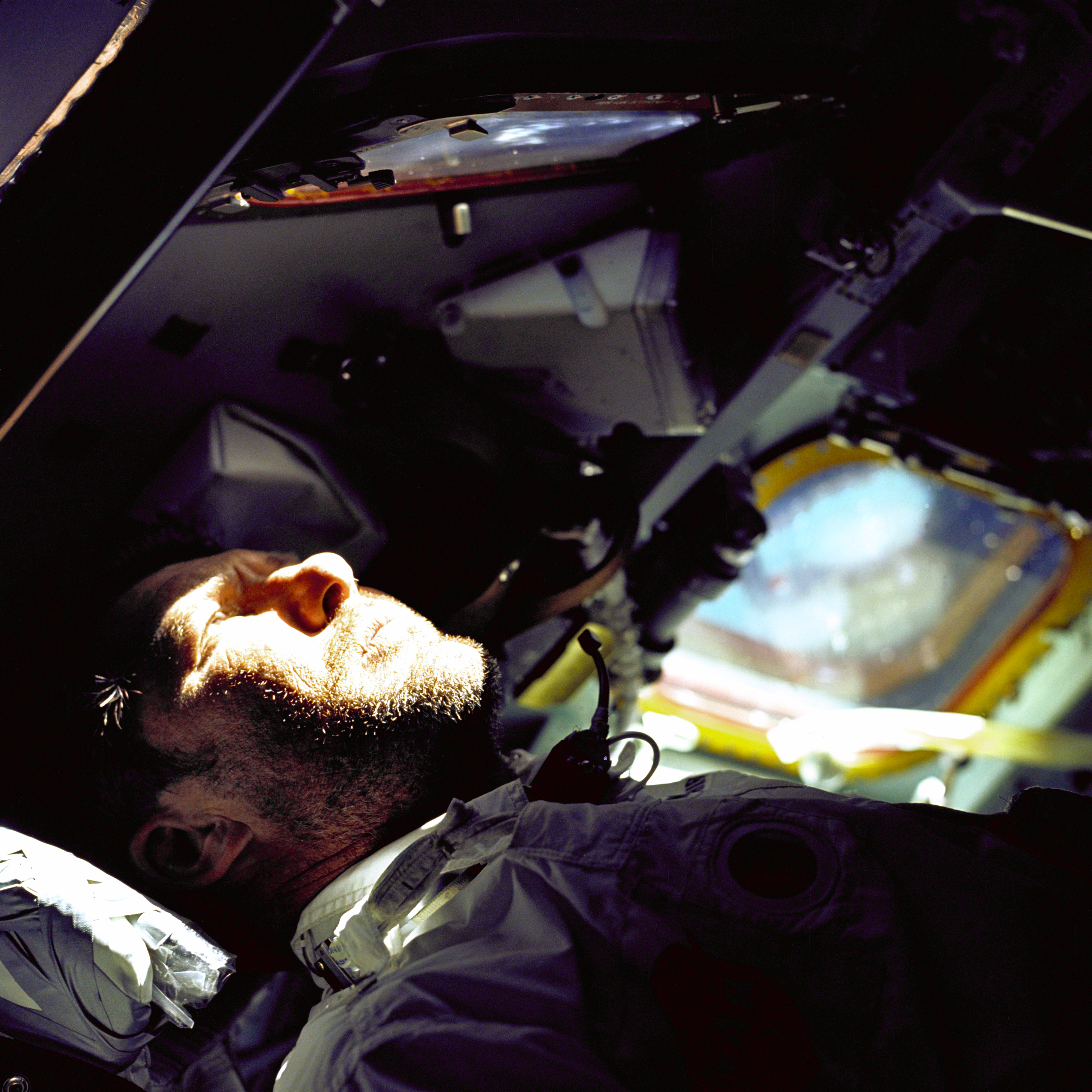A photo of a man sitting in the dark, in profile, looking out a window. His face is illuminated by a glaring light. Long dark whiskers — not quite a beard — bristle out across his cheek and chin. He isn’t a fugitive holed up in a motel room, watching the parking lot, but an astronaut: you can tell by the way the picture is oriented, so the window is at the top of the frame. He’s wearing a white jacket with zippers and pockets in unconventional places. What looks like a call-center hands-free microphone hangs around his neck.
In the background, there’s another window at a different angle (we’re in the command module, so the walls are curved and canted inward), and you can see that the glass is very thick, with bright yellow gaskets surrounding it.
One of the first things you notice about this picture is its extraordinary image quality. Even at high magnification, the details are sharp, with very little graininess. The exposure would have been tricky with such stark contrast between the dark shadow and bright light, but the photographer has captured a broad range of tones while only slightly overexposing the astronaut’s face. The colors have the hallucinogenic quality of Kodachrome. The shadows that take up most of the image are rendered in melancholy violets.
Maybe the next thing you notice about this picture is the expression on Walter Schirra’s face, of grim concern shading into fatalism. It’s the look of a father driving out of town at dawn, refusing to give false comfort to the kid in the passenger seat. We’re looking up at his face from slightly below, reinforcing the paternal impression. He’s a man with a lot on his mind.
One thing you might notice about Schirra’s expression is that it lacks completely the kind of hokey jollity or ennobled optimism that astronauts usually feel obliged to twist their faces around. Nearly all astronaut portraits reflect one or the other pole of this emotional propaganda campaign — the astronaut, despite the gravity of her mission, enjoys goofing off; the astronaut, with her god’s-eye-view of Earth, feels renewed hopefulness that mankind will overcome its violent parochialism and give peaceable coexistence a chance.
This picture is different. This is the astronaut as gnarled mariner, Odysseus or Ahab, damaged and determined and obsessed and merciless. He looks like he might have half a bottle of bourbon under the seat. He doesn’t look like someone who sleeps much.
Apollo 7 was Schirra’s third and final space flight; he was the only astronaut to fly in the Mercury, Gemini, and Apollo programs. While orbiting Earth on his last mission, Schirra developed a bad cold and became deeply irritable, snapping at his crew and at ground controllers. The mood of the three men in the command module grew strained. The virus spread. This photo was taken on day nine of the ten-day mission.
Apollo 7 was the first manned space mission after Gus Grissom, Ed White, and Roger Chaffee burned to death inside their command module during the Apollo 1 launch test on January 27, 1967. An unusually high cabin pressure and 100 percent oxygen mixture made everything in the capsule, from Velcro to aluminum, highly flammable. The astronauts had complained about the module’s fire hazards and its inward-swinging hatch, impossible to open against positive pressure. Schirra had been on a backup crew on January 27. After an earlier test he reportedly said, “There’s nothing wrong with this ship that I can point to, but it just makes me uncomfortable.”
It took five minutes for rescuers to get the hatch open on the day of the fire. “The personnel who had been involved in removing the hatches attempted to locate the crew without success,” reads NASA’s report on the accident. Once the smoke cleared, firefighters found the crew, their spacesuits and oxygen hoses so melted that it took 90 minutes to remove their bodies from the capsule.
(Originally posted on Medium)
